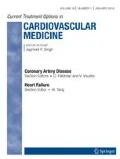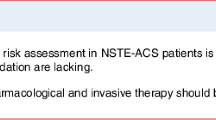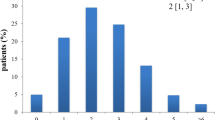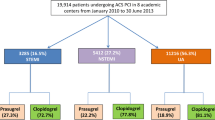Opinion statement
Risk stratification in acute coronary syndromes is important both for prognosis and for treatment. Consistently, using any of a variety of clinical predictors of risk, patients at highest risk for poor outcomes derive the greatest benefit from aggressive therapy with early coronary angiography, glycoprotein IIb/IIIa antagonists, or low molecular weight heparins. By contrast, patients at low risk may be managed conservatively without long-term impact on their risk of death or myocardial infarction. Several clinical and laboratory parameters have been identified as independent, powerful predictors of poor outcome, helping to distinguish high-risk from low-risk patients. Although not a substitute for astute clinical judgment, risk prediction scores may help clinicians to synthesize the relevant clinical data at presentation into an overall assessment of risk, allowing for cost-effective utilization of therapies that add significant expense and morbidity. With the ever-expanding range of pharmacologic and interventional therapies that impact the treatment of patients with unstable angina and non-ST-elevation myocardial infarction (NSTEMI), risk stratification will become increasingly important in targeting therapies to those who are likely to achieve the most benefit. In this review, we first consider the identifiable components of risk in patients presenting with unstable angina or NSTEMI and then evaluate the emerging information regarding differential response to treatment based on the presence of these risk factors.
Similar content being viewed by others
References and Recommended Reading
Yeghiazarians Y, Braunstein JB, Askari A, Stone PH: Unstable angina pectoris. N Engl J Med 2000, 342:101–114.
Braunwald E: Unstable angina: a classification. Circulation 1989, 80:410–414.
Calvin JE, Klein LW, VandenBerg BJ, et al.: Risk stratification in unstable angina: prospective validation of the Braunwald classification. JAMA 1995, 273:136–144.
Cannon CP, McCaber CH, Stone PH, et al.: Prospective validation of the Braunwald classification of unstable angina: results from the Thrombolysis in Myocardial Ischemia (TIMI) III Registry [abstract]. Circulation 1995, 92(suppl I):I-19.
Hamm CW, Braunwald E: A classification of unstable angina: revisited. Circulation 2000, 102:118–122.
Stone PH, Thompson B, Anderson VH: Influence of race, sex, and age on management of unstable angina and non-Q-wave myocardial infarction: the TIMI III Registry. JAMA 1996, 275:1104–1112.
Jacobs DR Jr, Kroenke C, Crow R, et al.: PREDICT: a simple risk score for clinical severity and long-term prognosis after hospitalization for acute myocardial infarction or unstable angina. Minnesota Heart Survey. Circulation 1999, 100:599–607.
Roger VL, Farkouh ME, Weston SA, et al.: Sex differences in evaluation and outcomes of unstable angina. JAMA 2000, 283:646–652.
Boersma E, Pieper KS, Steyerberg EW, et al.: Predictors of outcome in patients with acute coronary syndromes without persistent ST-segment elevation. Results from an international trial of 9461 patients. Circulation 2000, 101:2557–2567.
McGuire DK, Emanuelsson H, Charnwood A, et al.: Diabetes mellitus is associated with worse clinical outcomes across the spectrum of acute coronary syndromes: results from GUSTO IIb [abstract]. Circulation 1999, 100(suppl I):I-432.
Malmberg K, Yusuf S, Gerstein HC, et al.: Impact of diabetes on long-term prognosis in patients with unstable angina and non-Q-wave myocardial infarction: results of the OASIS (Organization to Assess Strategies for Ischemic Syndromes) Registry. Circulation 2000, 102:1013–1019.
Cotter G, Cannon CP, McCabe CH, et al.: Prior peripheral vascular disease and cerebrovascular disease are independent predictors of increased 1 year mortality in patients with acute coronary syndromes. Results from OPUS-TIMI 16. J Am Coll Cardiol 2000, 35:410A.
Jaber WA, Prior DL, Marso SP, et al.: CHF on presentation is associated with markedly worse outcomes among patients with acute coronary syndromes: PURSUIT trial findings [abstract]. Circulation 1999, 100(suppl I):I-433.
Taniguchi H, Iwasaka T, Takayama Y, et al.: Clinical characteristics of pulmonary edema in patients with unstable angina [Japanese]. J Cardiol 1992, 22(suppl):591–594.
Wright RS, Reeder GS, Herzog CA, et al.: Acute myocardial infarction and renal dysfunction: a high-risk combination. Ann Intern Med 2002, 1137:563–570.
Januzzi JL, Cannon CP, DiBattiste PM, et al.: Effects of renal insufficiency on early invasive management in patients with acute coronary syndromes (the TACTICS-TIMI 18 Trial). Am J Cardiol 2002, 90:1246–1249.
Helgason CM, Bolin KM, Hoff JA, et al.: Development of aspirin resistance in persons with previous ischemic stroke. Stroke 1994, 25:2331–2336.
Santopinto J, Gurfinkel SP, Torres V, et al.: Prior aspirin users with acute non-ST-elevation coronary syndromes are at increased risk of cardiac events and benefit from enoxaparin. Am Heart J 2001, 141:566–572.
Alexander JH, Harrington RA, Tuttle RH, et al.: Prior aspirin use predicts worse outcomes in patients with non-ST-elevation acute coronary syndromes. Am J Cardiol 1999, 83:1147–1151.
Sharis PH, Cannon CP, McCAber CH, et al.: Prior aspirin use is a univariate, but not a multivariate predictor of 1 year mortality in 10,302 patients with acute coronary syndromes: results from OPUS-TIMI 16. J Am Coll Cardiol 2000, 35(suppl A):392A.
Yusuf S, Zhao F, Mehta SR, et al.: Effects of clopidogrel in addition to aspirin in patients with acute coronary syndromes without ST-segment elevation. The CURE Investigators. N Engl J Med 2001, 345:494–502.
Lloyd-Jones DM, Camargo C, Lapuerta P, et al.: Electrocardiographic and clinical predictors of acute myocardial infarction in patients with unstable angina pectoris. Am J Cardiol 1998, 81:1182–1186.
Cannon CP, McCabe CH, Stone PH, et al.: The electrocardiogram predicts on-year outcome of patients with unstable angina and non-Q-wave myocardial infarction: results of the TIMI III Registry ECG Ancillary Study. J Am Coll Cardiol 1997, 30:133–140.
Savonitto S, Ardissino D, Granger CB, et al.: Prognostic value of the admission electrocardiogram in acute coronary syndromes. JAMA 1999, 281:707–713.
Barrabes JA, Figueras J, Moure C, et al.: Prognostic value of lead aVR in patients with a first non-ST-segment elevation acute myocardial infarction. Circulation 2003, 108:814–819.
Anderson HV, Cannon CP, Stone PH, et al.: One-year results of the Thrombolysis in Myocardial Infarction (TIMI) IIIB clinical trial. A randomized comparison of tissue-type plasminogen activator versus placebo and early invasive versus early conservative strategies in unstable angina and non-Q-wave myocardial infarction. J Am Coll Cardiol 1995, 26:1643–1650.
Cannon CP, Braunwald E: Unstable angina. In Heart Disease: A Textbook of Cardiovascular Medicine. edn 6. Edited by Braunwald E, et al. Philadelphia: WB Saunders; 2001:1232–1255.
Benamer H, Steg PG, Benessianno J, et al.: Elevated cardiac troponin I predicts a high-risk angiographic anatomy of the culprit lesion in unstable angina. Am Heart J 1999, 137:815–820.
Heeschen C, van Den Brand MJ, Hamm CW, Simoons ML: Angiographic findings in patients with refractory unstable angina according to troponin T status. Circulation 1999, 100:1509–1514.
Gibson CM, Murphy SA, Pai R, et al.: Elevations in troponin T are associated with abnormal tissue level perfusion: a TACTICS-TIMI 18 substudy [abstract]. Circulation 2001, 104:2708.
Antman EM, Tanasijevic MJ, Thompson B, et al.: Cardiacspecific troponin I levels to predict the risk of mortality in patients with acute coronary syndromes. N Engl J Med 1996, 335:1342–1349.
Ohman EM, Armstrong PW, Christenson RH, et al.: Cardiac troponin T levels for risk stratification in acute myocardial ischemia. N Engl J Med 1996, 335:1333–1341.
Hamm CW, Ravkilde J, Gerhardt W, et al.: The prognostic value of troponin T in unstable angina. N Engl J Med 1992, 327:146–150.
Lindahl B, Venge P, Wallentin L: Relation between troponin T and the risk of subsequent cardiac events in unstable coronary artery disease. FRISC Study Group. Circulation 1996, 93:1651–1657.
Newby LK, Christenson RH, Ohman EM, et al.: Value of serial troponin T measures for early and late risk stratification in patients with acute coronary syndromes. The GUSTO-IIa Investigators. Circulation 1998, 98:1853–1859.
Jernberg T, Lindahl B, James S, et al.: Comparison between strategies using creatine kinase-MB(mass), myoglobin, and troponin T in the early detection or exclusion of acute myocardial infarction in patients with chest pain and a nondiagnostic electrocardiogram. Am J Cardiol 2000, 86:1367–1371.
deWinter RJ, Koster RW, Sturk A, Sanders GT: Value of myoglobin, troponin T, and CK-MB mass in ruling out an acute myocardial infarction in the emergency room. Circulation 1995, 92:3401–3407.
de Lemos JA, Morrow DA, Gibson CM, et al.: The prognostic value of serum myoglobin in patients with non-ST-segment elevation acute coronary syndromes: results from the TIMI 11B and TACTICS-TIMI 18 studies. J Am Coll Cardiol 2002, 40:238–244.
Newby LK, Storrow AB, Gibler WB, et al.: Bedside multimarker testing for risk stratification in chest pain units: the Chest Pain Evaluation by Creatine Kinase-MB, Myoglobin, and Troponin I (CHECKMATE) study. Circulation 2001, 103:1832–1837.
Blake G, Ridker PM: Novel clinical markers of vascular wall inflammation. Circ Res 2001, 89:763–771.
Liuzzo G, Biasucci LM, Gallimore JR, et al.: The prognostic value of C-reactive protein and serum amyloid A in severe unstable angina. N Engl J Med 1994, 331:417–424.
Morrow DA, Rifai N, Antman EM, et al.: C-reactive protein is a potent predictor of mortality independently and in combination with troponin T in acute coronary syndromes: a TIMI 11A substudy. J Am Coll Cardiol 1998, 31:1460–1465.
Biasucci LM, Liuzzo G, Grillo RL, et al.: Elevated levels of C-reactive protein at discharge in patients with unstable angina predict recurrent instability. Circulation 1999, 99:855–860.
Sabatine MS, Morrow DA, Cannon CP, et al.: Relationship between baseline white blood cell count and degree of coronary artery disease and mortality in patients with acute coronary syndromes a TACTICSTIMI 18 (Treat Angina with Aggrastat and determine Cost of Therapy with an Invasive or Conservative Strategy-Thrombolysis in Myocardial Infarction 18 trial) substudy. J Am Coll Cardiol 2002, 40:1761–1768.
Morrow DA, Rifai N, Antman EM, et al.: Serum amyloid A predicts early mortality in acute coronary syndromes: a TIMI 11A substudy. J Am Coll Cardiol 2000, 35:358–362.
Lindmark E, Diderholm E, Wallentin L, Siegbahn A: Relationship between Interleukin-6 and mortality in patients with unstable coronary artery disease: effects of an early invasive or noninvasive strategy. JAMA 2001, 286:2107–2113.
Blankenberg S, Tiret L, Bickel C, et al.: Interleukin-18 is a strong predictor of cardiovascular death in stable and unstable angina. Circulation 2002, 106:24–30.
Mach F, Schonbeck U, Sukhova GK, et al.: Reduction of atherosclerosis in mice by inhibition of CD40 signalling. Nature 1998, 394:200–203.
Schonbeck U, Varo N, Libby P, et al.: Soluble CD40L and cardiovascular risk in women. Circulation 2001, 104:2266–2268.
Heeschen C, Dimmeler S, Hamm CW, et al.: Soluble CD40 ligand in acute coronary syndromes. N Engl J Med 2003, 348:1104–1111.
de Lemos JA, Morrow DA, Bentley JH, et al.: The prognostic value of B-type natriuretic peptide in patients with acute coronary syndromes. N Engl J Med 2001, 345:1014–1021.
Morrow DA, de Lemos JA, Sabatine MS, et al.: Evaluation of B-type natriuretic peptide for risk assessment in unstable angina/non-ST elevation MI: BNP and prognosis in TACTICS-TIMI 18. J Am Coll Cardiol 2003, 41:1264–1272.
James SK, Lindahl B, Siegbahn A, et al.: N-terminal probrain natriuretic peptide and other risk markers for the separate prediction of mortality and subsequent myocardial infarction in patients with unstable coronary artery disease: a Global Utilization of Strategies To Open occluded arteries (GUSTO)-IV substudy. Circulation 2003, 108:275–281.
Stone PH, Thompson B, Zaret BL, et al.: Factors associated with failure of medical therapy in patients with unstable angina and non-Q wave myocardial infarction: a TIMI-IIIB database study. Eur Heart J 1999, 20:1084–1093.
Solomon DH, Ganz DA, Avorn J, et al.: Which patients with unstable angina and non-Q-wave myocardial infarction should have immediate cardiac catheterization? A clinical decision rule for predicting who will fail medical therapy. J Clin Epidemiol 2002, 55:121–128.
Solomon DH, Stone PH, Glynn RJ, et al.: Use of risk stratification to identify patients with unstable angina likeliest to benefit from an invasive versus conservative management strategy. J Am Coll Cardiol 2001, 38:969–976. Outlines a risk stratification algorithm that predicts risk of adverse events and benefit from an early invasive management strategy in patients with UA.
Holper EM, Antman EM, McCabe CH, et al.: A simple, readily available method for risk stratification of patients with unstable angina or non-Q myocardial infarction: a TIMI 11B substudy. Circulation 1998, 98:I-493.
Antman EM, Cohen M, Bernink PJ, et al.: The TIMI risk score for unstable angina/non-ST elevation MI: a method for prognostication and therapeutic decision making. JAMA 2000, 284:835–842. Demonstrates the derivation and validation of an integrative risk stratification scheme that predicts risk of death or recurrent ischemic events and response to enoxaparin among patients presenting with UA.
Sabatine MS, Morrow DA, de Lemos JA, et al.: Multimarker approach to risk stratification in non-STelevation acute coronary syndromes: simultaneous assessment of troponin I, C-reactive protein, and B-type natriuretic peptide. Circulation 2002, 105:1760–1763. The only study to date looking at the predictive ability of novel cardiac markers in isolation and in combination among patients with non-ST-elevation ACS.
Morrow DA, Braunwald E: Future of biomarkers in acute coronary syndromes: moving toward a multimarker strategy. Circulation 2003, 108:250–252. Outlines the state of the art in cardiac risk assessment using biomarkers and speculates about the future of multimarker strategies in the management of patients with ACS.
Antman EM, McCabe CH, Gurfinkel EP, et al.: Enoxaparin prevents death and cardiac ischemic events in unstable angina and non-Q-wave myocardial infarction: results of the Thrombolysis In Myocardial Infarction (TIMI) 11B trial. Circulation 1999, 100:1593–1601.
Inhibition of platelet glycoprotein IIb/IIIa with eptifibatide in patients with acute coronary syndromes. The PURSUIT Trial Investigators [no authors listed]. N Engl J Med 1998, 339:436–443.
Inhibition of the platelet glycoprotein IIb/IIIa receptor with tirofiban in unstable angina and non-Q-wave myocardial infarction. The Platelet Receptor Inhibition for Ischemic Syndrome Management in Patients Limited by Unstable Signs and Symptoms (PRISMPLUS) Trial Investigators [no authors listed]. N Engl J Med 1998, 338:1488–1497.
Januzzi JL, Sabatine MS, Wan Y, et al.: Interactions between age, outcome of acute coronary syndromes, and tirofiban therapy. Am J Cardiol 2003, 91:457–461.
Cannon CP, Weintraub WS, Demopoulos LA, et al.: Comparison of early invasive and conservative strategies in patients with unstable coronary syndromes treated with the glycoprotein IIb/IIIa inhibitor tirofiban. N Engl J Med 2001, 344:1879–1887.
Beckman JA, Creager MA, Libby P: Diabetes and atherosclerosis: epidemiology, pathophysiology, and management. JAMA 2002, 287:2570–2581.
Theroux P, Alexander J, Pharand C, et al.: Glycoprotein IIb/ IIIa receptor blockade improves outcomes in diabetic patients presenting with unstable angina/non-ST-elevation myocardial infarction: results from the Platelet Receptor Inhibition in Ischemic Syndrome Management in Patients Limited by Unstable Signs and Symptoms (PRISM-PLUS) Study. Circulation 2000, 102:2466–2472.
Cannon CP, Weintraub WS, Demopoulos LA, et al.: Comparison of early invasive and conservative strategies in patients with unstable coronary syndromes treated with the glycoprotein IIb/IIIa inhibitor tirofiban. N Engl J Med 2001, 344:1879–1887.
Holmvang L, Clemmensen P, Lindahl B, et al.: Quantitative analysis of the admission electrocardiogram identifies patients with unstable coronary artery disease who benefit the most from early invasive treatment. J Am Coll Cardiol 2003, 41:905–915.
Heeschen C, Hamm CW, Goldmann B, et al.: Troponin concentrations for stratification of patients with cute coronary syndromes in relation to therapeutic efficacy of tirofiban. Lancet 1999, 254:1757–1762.
Morrow DA, Antman EM, Tanasijevic M, et al.: Cardiac troponin I for stratification of early outcomes and the efficacy of enoxaparin in unstable angina: a TIMI 11B substudy. J Am Coll Cardiol 2000, 36:1812–1817.
Morrow DA, Cannon CP, Rifai N, et al.: Ability of minor elevations of troponins I and T to predict benefit from an early invasive strategy in patients with unstable angina and non-ST elevation myocardial infarction: results from a randomized trial. JAMA 2001, 286:2405–2412. This recently published substudy of the TACTICS-TIMI 18 trial demonstrates the power of cardiac troponins as an independent predictor for prognosis and therapeutic decision making in patients with UA and NSTEMI.
Morrow DA, Antman EA, Snappin SM, et al.: An integrated clinical approach to predicting the benefit of tirofiban in non-ST-elevation acute coronary syndromes. Application of the TIMI-risk score for UA/NSTEMI in PRISMPLUS. Eur Heart J 2002, 23:187–191.
Desai AS, Solomon DH, Stone PH: Economic consequences of routine coronary angiography in low-risk patients with unstable angina. J Am Coll Cardiol 2002, 39(5suppl A):447A.
Mahoney EM, Jurkovitz CT, Chu H, et al.: Cost and costeffectiveness of an early invasive vs conservative strategy for the treatment of unstable angina and non-STsegment elevation myocardial infarction. JAMA 2002, 288:1851–1858.
Author information
Authors and Affiliations
Rights and permissions
About this article
Cite this article
Desai, A.S., Stone, P.H. Risk stratification in patients with unstable angina and non-ST-elevation myocardial infarction. Curr Treat Options Cardio Med 6, 3–14 (2004). https://doi.org/10.1007/s11936-004-0010-y
Issue Date:
DOI: https://doi.org/10.1007/s11936-004-0010-y




